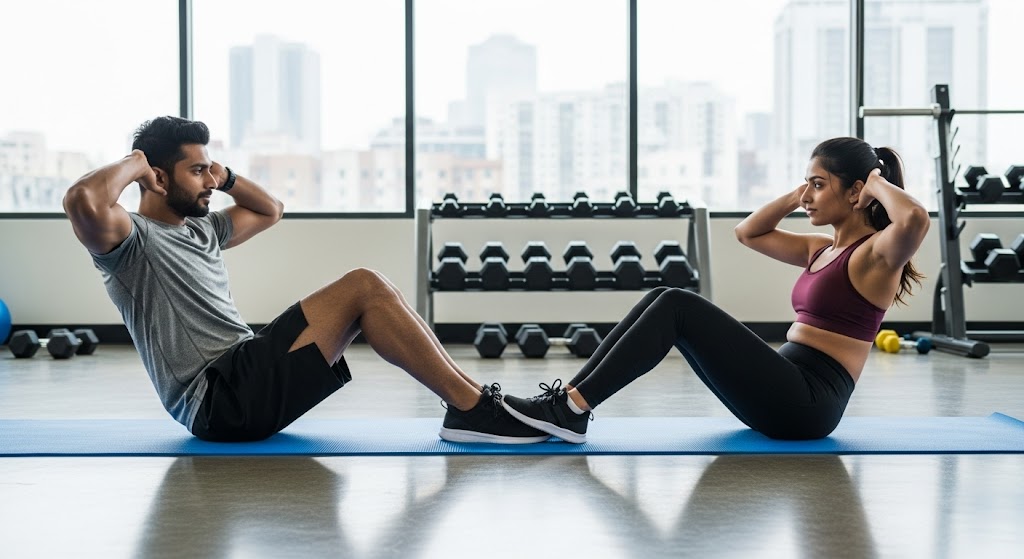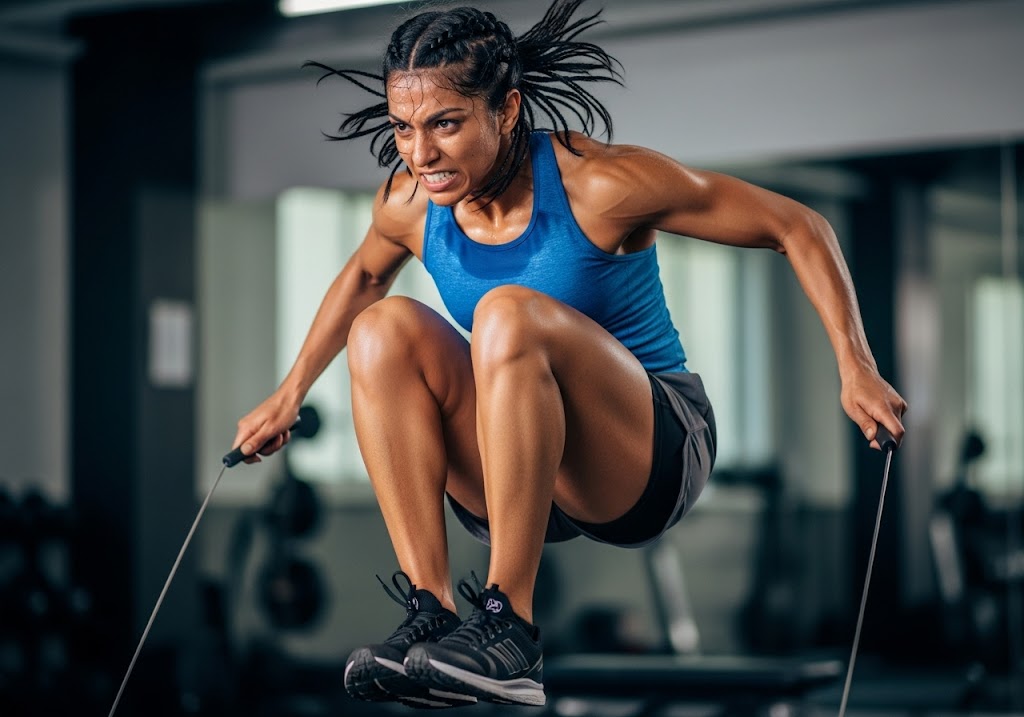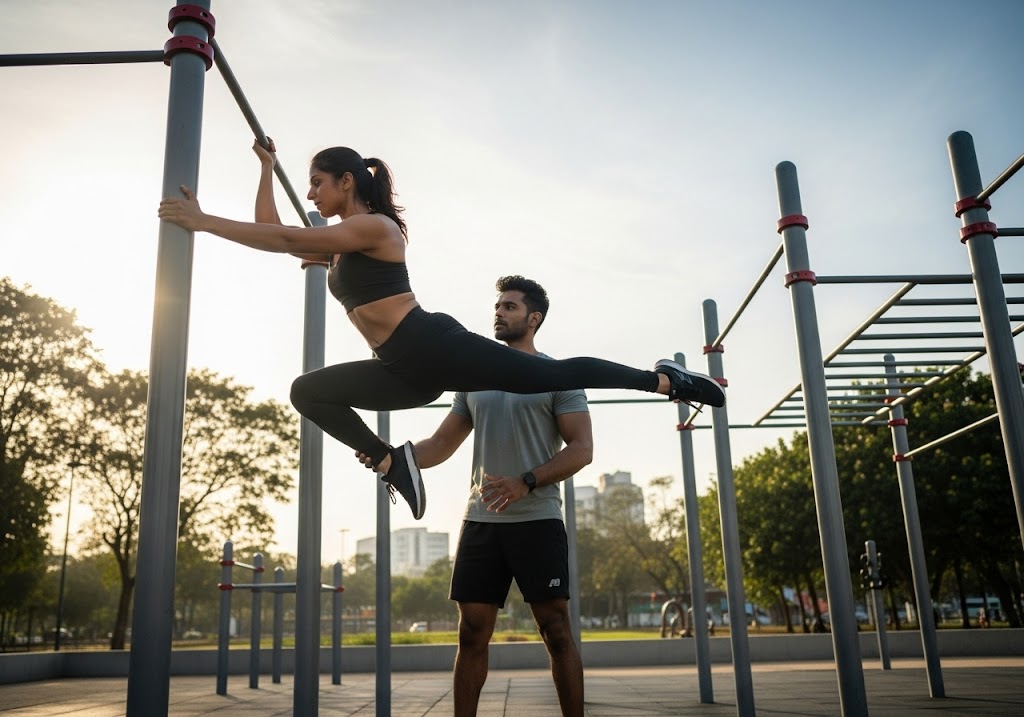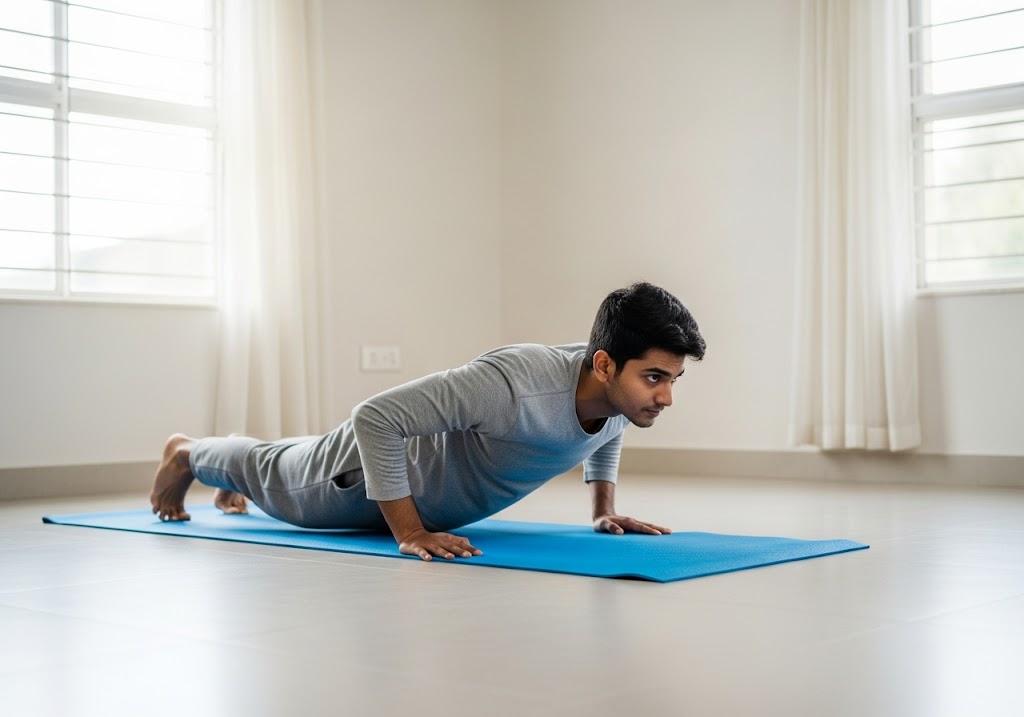Calisthenics vs weightlifting differs primarily in that calisthenics uses bodyweight for functional strength and skill development, while weightlifting uses external resistance for maximum muscle mass and absolute strength gains. Key differences in calisthenics vs weightlifting are: Bodyweight vs external resistance, functional movements vs isolated exercises, equipment-free vs gym-dependent, progressive difficulty vs progressive loading, compound movements vs targeted training, skill development vs strength focus, flexibility requirements vs lifting technique, and convenience vs maximum load capacity.
Choosing between calisthenics vs weightlifting can transform your fitness journey and determine your training success for years to come. Both approaches offer unique benefits for building muscle, strength, and athletic performance, but they work through different mechanisms and suit different lifestyles. Understanding the fundamental differences helps you make the right choice for your goals, schedule, and preferences.
Table of Contents
What is Calisthenics?
Calisthenics involves using your body weight as resistance to build strength, flexibility, and coordination through natural movement patterns. This training method emphasizes functional movements that develop real-world strength while improving mobility, balance, and body control. From basic push-ups to advanced moves like human flags, calisthenics offers progressive challenges that grow with your abilities.
The beauty of calisthenics lies in its accessibility and scalability, requiring minimal equipment while providing maximum results. Athletes develop impressive strength-to-weight ratios, exceptional body control, and functional fitness that translates to daily activities and sports performance. This approach builds lean muscle mass while enhancing flexibility and coordination simultaneously.
For beginners starting their calisthenics journey, exploring bodyweight exercises for beginners provides essential foundation movements for safe and effective progression.

What is Weightlifting?
Weightlifting utilizes external resistance through barbells, dumbbells, and machines to build maximum strength and muscle mass. This approach allows for precise loading adjustments and isolated muscle targeting, making it ideal for bodybuilding, powerlifting, and strength development goals. Progressive overload becomes straightforward through incremental weight increases over time.
The controlled environment of weightlifting enables focused muscle development and measurable progress tracking through specific load increases. Athletes can target individual muscles with surgical precision while building impressive size and strength through heavy resistance training. This method excels at creating maximum muscle hypertrophy and raw strength development.
Understanding when to combine cardio with weight training, such as learning is it better to do cardio before or after weights, optimizes training results and workout efficiency.
Calisthenics vs Weightlifting: Difference Between Bodyweight and Weight Training
The fundamental difference between bodyweight and weight training lies in resistance source and movement complexity. Bodyweight training uses your own mass as resistance through multi-joint, functional movements, while weight training employs external loads for targeted muscle development. Each approach creates distinct adaptations in strength, muscle building, and athletic performance.
| Training Aspect | Bodyweight Training | Weight Training | Key Difference |
|---|---|---|---|
| Resistance Source | Body weight | External weights | Fixed vs Variable load |
| Movement Patterns | Compound, functional | Isolated or compound | Complexity level |
| Equipment Needs | Minimal to none | Extensive equipment | Accessibility factor |
| Progression Method | Skill and leverage | Weight increases | Advancement type |
| Space Requirements | Minimal space | Gym or home gym | Location flexibility |
| Injury Risk | Lower impact | Higher with heavy loads | Safety profile |
| Muscle Building | Moderate to good | Excellent | Hypertrophy potential |
| Strength Development | Relative strength | Absolute strength | Strength type |
| Cost Factor | Virtually free | Equipment/gym costs | Economic impact |
| Learning Curve | Moderate to high | Low to moderate | Skill requirements |
For comprehensive bodyweight training routines, basic calisthenics workout provides structured programs for systematic development.
Pros and Cons of Calisthenics
Understanding the advantages and limitations of calisthenics helps determine if this training method aligns with your fitness goals and lifestyle preferences. These factors significantly impact long-term adherence and success in your fitness journey.
Advantages of Calisthenics Training
Calisthenics offers unique benefits that make it attractive for many fitness enthusiasts seeking functional strength and convenience. These advantages often make calisthenics the preferred choice for those prioritizing practicality and natural movement development.
- Equipment-Free Training: Requires minimal to no equipment, making workouts possible anywhere at any time
- Functional Strength: Develops strength patterns that directly transfer to daily activities and sports performance
- Improved Flexibility: Multi-joint movements naturally enhance mobility and range of motion throughout training
- Cost-Effective: Virtually free once basic techniques are learned, eliminating gym memberships and equipment costs
- Scalable Difficulty: Endless progressions from beginner to advanced levels keep training challenging and engaging
- Lower Injury Risk: Bodyweight loads reduce joint stress and overuse injury potential compared to heavy lifting
- Full-Body Integration: Most exercises work multiple muscle groups simultaneously for efficient total-body development
- Skill Development: Advanced movements require coordination, balance, and body awareness beyond simple strength
Wonder which squat variation is more effective? Compare muscle engagement and mobility demands in front squat vs back squat
Disadvantages of Calisthenics Training
Despite its benefits, calisthenics presents certain limitations that may not suit everyone’s goals or preferences. Understanding these challenges helps set realistic expectations and training approaches.
- Limited Load Progression: Cannot add infinite resistance like external weights, potentially limiting strength gains
- Steep Learning Curve: Advanced movements require significant time and practice to master proper technique
- Lower Muscle Building: May not provide optimal stimulus for maximum muscle hypertrophy compared to weights
- Imbalanced Development: Some muscle groups may be harder to target effectively through bodyweight exercises alone
- Progress Tracking: Difficult to measure progress objectively without clear weight or repetition increases
- Weather Dependency: Outdoor training can be limited by weather conditions and seasonal changes
For advanced calisthenics progressions, calisthenics planche demonstrates the skill development potential of bodyweight training.
Pros and Cons of Weightlifting
Weightlifting offers distinct advantages and challenges that make it suitable for specific goals and training preferences in calisthenics vs weightlifting comparison. Understanding these factors helps determine if weightlifting aligns with your fitness objectives and lifestyle constraints.
Advantages of Weightlifting Training
Weightlifting provides unmatched potential for building maximum muscle mass and strength through progressive external loading. These benefits make it the preferred choice for serious muscle building, strength development, and physique transformation goals.
- Maximum Muscle Building: Heavy external loads provide optimal stimulus for muscle hypertrophy and mass development
- Progressive Overload: Easy progression through incremental weight increases allows continuous strength advancement
- Targeted Development: Isolation exercises allow precise targeting of specific muscles for balanced physique development
- Measurable Progress: Clear weight and repetition tracking provides objective feedback and motivation
- Strength Specialization: Develops maximum absolute strength through heavy compound movements and progressive loading
- Time Efficiency: Focused training sessions can build significant muscle in shorter time periods
- Variety: Endless exercise combinations with different equipment prevent boredom and plateaus
- Social Environment: Gym atmosphere provides community support and motivation for consistent training
Master the proper form and technique to maximize core engagement with how to do flutter kicks
Disadvantages of Weightlifting Training
Despite its muscle-building advantages, weightlifting presents limitations that may not suit everyone’s goals or circumstances. These challenges require consideration when choosing between calisthenics vs weightlifting approaches.
- Equipment Dependency: Requires gym access or expensive home equipment for effective training sessions
- Higher Injury Risk: Heavy loads increase potential for acute injuries with improper form or technique
- Cost Factor: Ongoing gym memberships or equipment purchases create significant financial investment
- Limited Functional Transfer: Isolated movements may not translate well to real-world activities
- Space Requirements: Home gyms require substantial space for equipment and safe training environment
- Technique Complexity: Learning proper form with heavy weights requires instruction and practice time
Check out how many steps to burn 500 calories and discover smart ways to work it into your daily routine.

Calisthenics vs Gym: Which is Better?
The calisthenics vs gym debate depends entirely on individual goals, preferences, and circumstances rather than one approach being universally superior. Each method excels in different areas and serves different purposes in comprehensive fitness development.
| Comparison Factor | Calisthenics | Gym/Weightlifting | Winner |
|---|---|---|---|
| Convenience | Train anywhere, anytime | Limited to gym hours | Calisthenics |
| Cost | Free after learning | Monthly fees + equipment | Calisthenics |
| Muscle Building | Good for lean muscle | Excellent for mass | Gym |
| Strength Development | Relative strength | Absolute strength | Depends on goals |
| Functional Movement | Excellent transfer | Limited transfer | Calisthenics |
| Progress Tracking | Skill-based progression | Weight-based progression | Gym |
| Injury Risk | Lower risk | Higher with heavy weights | Calisthenics |
| Equipment Needs | Minimal | Extensive | Calisthenics |
| Social Aspect | Often solo training | Community environment | Gym |
| Weather Independence | Can be weather dependent | Climate controlled | Gym |
The optimal choice depends on your specific goals, available time, budget, and personal preferences. Many successful athletes combine both approaches strategically to maximize benefits while minimizing limitations.
For a detailed comparison between training environments, calisthenics vs gym provides comprehensive analysis of both approaches.
Calisthenics vs Lifting Results
Results from calisthenics vs weightlifting vary significantly based on training consistency, program design, and individual genetic factors. Both methods can produce impressive physique and performance improvements when applied correctly, but they excel in different areas of development.
| Result Category | Calisthenics Results | Weightlifting Results | Timeline |
|---|---|---|---|
| Physique Type | Lean, athletic build | Muscular, mass-focused | 6-12 months |
| Muscle Definition | Excellent definition | Variable based on diet | 3-6 months |
| Strength Type | Relative strength | Absolute strength | 2-4 months |
| Body Fat | Naturally lower | Requires diet focus | 3-8 months |
| Flexibility | Improved mobility | May decrease without focus | 1-3 months |
| Coordination | Significantly improved | Minimal improvement | 2-6 months |
| Skill Mastery | Complex movement skills | Basic movement patterns | 6-24 months |
| Functional Strength | Excellent carryover | Limited transfer | 2-6 months |
| Muscle Size | Moderate increases | Maximum potential | 6-18 months |
| Performance | Movement quality | Lifting performance | 1-6 months |
For understanding calorie burn differences, how many push ups to burn 100 calories provides insights into calisthenics energy expenditure.
Calisthenics vs Weightlifting: Which Builds More Muscle?
The question of which builds more muscle in calisthenics vs weightlifting depends on training variables, individual factors, and specific muscle groups targeted. Both methods can build significant muscle when programmed correctly with progressive overload principles applied consistently.
| Muscle Building Factor | Calisthenics | Weightlifting | Advantage |
|---|---|---|---|
| Upper Body Muscle | Excellent development | Superior mass building | Weightlifting |
| Lower Body Muscle | Limited by bodyweight | Unlimited load capacity | Weightlifting |
| Core Muscle | Outstanding integration | Good with specific training | Calisthenics |
| Muscle Definition | Natural lean appearance | Requires diet management | Calisthenics |
| Muscle Size Potential | Moderate to good | Maximum potential | Weightlifting |
| Functional Muscle | Superior integration | Isolated development | Calisthenics |
| Progressive Overload | Skill/leverage based | Weight-based progression | Weightlifting |
| Time to Build Muscle | Slower initial gains | Faster visible results | Weightlifting |
| Muscle Symmetry | Natural proportions | Can create imbalances | Calisthenics |
| Long-term Building | Sustainable development | Equipment dependent | Depends on access |
For advanced single-arm progressions, how to do a one arm push up demonstrates the muscle-building potential of advanced calisthenics movements.

Calisthenics vs Weightlifting: Which Burns More Calories?
Calorie burn in calisthenics vs weightlifting depends on training intensity, duration, body weight, and specific exercises performed. Both methods can provide excellent calorie expenditure when structured for metabolic conditioning and fat loss goals.
| Training Method | Calories per Hour* | Factors Affecting Burn | Best For Fat Loss |
|---|---|---|---|
| Calisthenics | 400-600 | Body weight, intensity, complexity | Circuit training |
| Weightlifting | 300-500 | Weight load, rest periods, volume | Compound movements |
| HIIT Calisthenics | 500-800 | Work-to-rest ratios, movement selection | Maximum burn |
| Heavy Lifting | 350-600 | Load intensity, compound movements | Afterburn effect |
*Values for 70kg individual; actual burn varies by body weight and training intensity
Curious how much fat you can burn with flutter kicks? Get the numbers in flutter kicks calories burned per minute
Metabolic Training Considerations
Calisthenics often provides higher calorie burn during exercise due to full-body compound movements and continuous motion patterns. Circuit-style training with minimal rest between exercises elevates heart rate and maintains high energy expenditure throughout the session.
Weightlifting may burn fewer calories during exercise but can create significant afterburn effect (EPOC) through heavy compound movements and high training intensity. The metabolic demand of muscle repair and adaptation continues burning calories for hours after the workout ends.
For specific calorie burn examples, how many calories does a plank burn and 100 squats burn how many calories provide detailed energy expenditure information.
Calisthenics vs Weightlifting: Best Workout Method for Fitness
Determining the best workout method for overall fitness in calisthenics vs weightlifting requires defining what “overall fitness” means to you. Comprehensive fitness typically includes strength, endurance, flexibility, balance, coordination, and body composition – areas where both methods contribute differently.
Holistic Fitness Development
Calisthenics excels at developing multiple fitness components simultaneously through integrated movement patterns. A single workout can improve strength, flexibility, balance, and coordination while building functional movement capacity. This approach closely mimics real-world movement demands and athletic requirements.
Weightlifting specializes in strength and muscle development but may require additional training modalities for complete fitness. Adding cardiovascular exercise, flexibility work, and balance training creates a more comprehensive program when combined with weight training for optimal results.
Want defined triceps without weights? Explore effective bodyweight moves in calisthenics for triceps
Practical Implementation Strategies
The most effective approach for overall fitness often combines elements from both calisthenics and weightlifting based on individual needs and goals. This hybrid approach maximizes benefits while minimizing limitations of either method alone.
- Foundation Phase: Start with calisthenics to build movement quality and basic strength
- Strength Phase: Incorporate weights for maximum strength and muscle development
- Integration Phase: Combine both methods for comprehensive fitness development
- Specialization: Emphasize preferred method while maintaining other elements
- Periodization: Cycle focus between methods based on seasonal goals and preferences
For comprehensive calisthenics programming, full body calisthenics workout provides complete routine structures.

Calisthenics vs Weightlifting: Training Frequency and Recovery
Training frequency and recovery needs differ between calisthenics vs weightlifting due to varying stress patterns and muscle damage mechanisms. Understanding these differences optimizes program design and prevents overtraining while maximizing adaptation for both training approaches.
| Recovery Factor | Calisthenics | Weightlifting | Optimal Approach |
|---|---|---|---|
| Training Frequency | 5-6 days per week | 3-5 days per week | Higher for calisthenics |
| Muscle Damage | Lower mechanical stress | Higher muscle damage | Less recovery needed |
| Nervous System | Skill-based fatigue | Strength-based fatigue | Different recovery types |
| Active Recovery | Daily light practice | Complete rest preferred | Movement for calisthenics |
| Sleep Requirements | 7-8 hours adequate | 8-9 hours optimal | More for weightlifting |
| Recovery Methods | Mobility, light movement | Rest, nutrition focus | Method-specific approach |
| Overtraining Risk | Lower due to bodyweight | Higher with heavy loads | Monitor lifting more |
| Between-Set Rest | 30-90 seconds | 2-5 minutes | Shorter for calisthenics |
| Muscle Soreness | Less severe typically | More intense soreness | Manage lifting carefully |
| Recovery Time | 24-48 hours | 48-72 hours | Faster calisthenics recovery |
Understanding recovery factors like should you exercise with sore muscles helps optimize training frequency for both approaches.
Calisthenics vs Weightlifting: Skill Development vs Strength Focus
The emphasis on skill development versus pure strength varies dramatically between calisthenics vs weightlifting approaches. This difference affects training methodology, progression patterns, and long-term development paths for practitioners choosing between these training methods.
| Development Aspect | Calisthenics Skill Focus | Weightlifting Strength Focus | Key Difference |
|---|---|---|---|
| Learning Curve | Months to years for mastery | Weeks to months for basics | Complexity level |
| Progression Method | Skill advancement | Weight increases | Advancement type |
| Movement Complexity | Highly complex patterns | Simple to moderate patterns | Technical demands |
| Coordination Needs | Essential for advancement | Helpful but not critical | Skill requirements |
| Practice Frequency | Daily skill practice ideal | 3-5 sessions sufficient | Training frequency |
| Mastery Timeline | 2-5 years for advanced moves | 6-12 months for strength | Development speed |
| Body Awareness | Exceptional development | Moderate development | Proprioception gains |
| Mental Challenge | High cognitive demand | Moderate mental focus | Learning complexity |
| Performance Metrics | Skill achievement | Weight/reps lifted | Success measurement |
| Long-term Goals | Movement mastery | Strength maximization | Ultimate objectives |
Calisthenics vs Weightlifting: Equipment and Accessibility
Equipment requirements and accessibility represent major factors in the calisthenics vs weightlifting decision. These practical considerations often determine long-term adherence and consistency more than training effectiveness alone.
Calisthenics requires minimal equipment investment, making it accessible to virtually everyone regardless of economic situation or location. A pull-up bar and basic knowledge can provide years of progressive training without additional costs or equipment needs.
Weightlifting requires significant equipment investment for home training or ongoing gym membership costs. This financial barrier may limit accessibility for some individuals, though it provides access to unlimited loading potential and specialized equipment.
For equipment-free alternatives, calisthenics exercises provides comprehensive movement libraries requiring minimal setup.
Calisthenics vs Weightlifting: Injury Prevention and Safety
Injury rates and safety profiles differ between calisthenics vs weightlifting due to loading patterns, movement complexity, and force requirements. Understanding these differences helps choose appropriate training methods based on injury history and risk tolerance.
Calisthenics Safety Profile
Bodyweight training generally presents lower injury risk due to limited loading and natural movement patterns that respect joint ranges of motion. The progressive nature of skill development typically prevents individuals from attempting movements beyond their current capacity.
Weightlifting Injury Considerations
Heavy weightlifting carries higher injury risk, particularly with improper form or excessive loading. The ability to load beyond natural capacity can lead to acute injuries if technique breaks down or recovery is inadequate.
For injury prevention strategies, warm up exercises for beginners provides essential preparation protocols for both training methods.
Calisthenics vs Weightlifting: Progressive Overload Potential
Progressive overload forms the foundation of strength development, but calisthenics and weightlifting achieve it through fundamentally different mechanisms. While weightlifting offers straightforward load increases through added plates, calisthenics requires creative progression strategies. Understanding each method’s overload potential helps optimize training outcomes for specific goals.
Progressive Overload Comparison
| Aspect | Calisthenics | Weightlifting |
|---|---|---|
| Load Increment | Body positioning, lever arms, range of motion | Weight plates (2.5lb-45lb increments) |
| Precision Control | Limited – large jumps between progressions | High – precise weight adjustments |
| Overload Methods | Progression exercises, tempo, reps, sets | Adding weight, reps, sets, intensity techniques |
| Beginner Progression | May start too advanced for some | Easily scalable from very light weights |
| Advanced Progression | Extremely challenging skills available | Unlimited weight addition potential |
| Measurability | Difficult to quantify exact load | Precise load measurement |
| Consistency | Varies with fatigue, body weight changes | Consistent external load |
| Long-term Potential | Skill-based plateaus possible | Strength plateaus with heavy loads |
| Micro-progression | Challenging – large gaps between levels | Easy – small weight increments |
| Overload Ceiling | Body weight limitations for some exercises | Theoretically unlimited |
Calisthenics vs Weightlifting: Technique
Technique mastery distinguishes successful athletes in both disciplines, but the complexity and learning curves differ significantly. Calisthenics demands intricate body awareness and coordination, while weightlifting focuses on efficient force production patterns. Both require dedicated practice for safe, effective execution and long-term progression.
Technique Comparison
| Aspect | Calisthenics | Weightlifting |
|---|---|---|
| Learning Curve | Steep – complex body positioning | Moderate – structured movement patterns |
| Skill Complexity | High – multiple muscle coordination | Moderate – focused movement patterns |
| Form Requirements | Precise body alignment, core stability | Proper joint mechanics, bar path |
| Progression Prerequisites | Master basic before advanced movements | Can progress with basic technique |
| Body Awareness | Exceptional proprioception required | Moderate spatial awareness needed |
| Coaching Necessity | Beneficial but not always accessible | Highly recommended for safety |
| Self-Assessment | Difficult without video/mirrors | Easier to self-monitor |
| Injury Risk | Lower load but complex positions | Higher loads with simpler positions |
| Technical Plateaus | Common – skills take months/years | Less common – focus on strength |
| Movement Quality | Emphasizes perfect form throughout | Form may break down at max efforts |
Calisthenics vs Weightlifting: Variations
Exercise variety keeps training engaging while targeting muscles through different angles and movement patterns. Calisthenics offers creative bodyweight variations, while weightlifting provides diverse equipment and loading options. Both disciplines feature extensive exercise libraries, though accessibility and equipment requirements vary significantly between approaches.
Variations Comparison
| Aspect | Calisthenics | Weightlifting |
|---|---|---|
| Exercise Variety | 100+ bodyweight variations | 1000+ exercises with different equipment |
| Equipment Dependency | Minimal – bars, rings, parallettes | High – barbells, dumbbells, machines |
| Muscle Targeting | Compound movements, multiple muscles | Isolation and compound options |
| Movement Planes | All planes with creative positioning | All planes with equipment variety |
| Functional Patterns | Highly functional, real-world movements | Mix of functional and isolated patterns |
| Accessibility | High – requires minimal equipment | Low – gym membership often necessary |
| Cost Factor | Very low ongoing costs | High equipment/membership costs |
| Space Requirements | Minimal indoor/outdoor space | Dedicated gym space needed |
| Creativity Factor | High – endless position modifications | Moderate – equipment-dependent variations |
| Scalability | Self-scaling through progressions | Infinite scaling through load |
Calisthenics vs Weightlifting: Similarities Between
Despite apparent differences, calisthenics and weightlifting share fundamental training principles and physiological adaptations. Both disciplines develop strength, muscle mass, and athleticism through progressive resistance training. Understanding these commonalities reveals why many elite athletes incorporate elements from both approaches for comprehensive physical development.
Similarities Between Calisthenics and Weightlifting
- Strength Development: Both disciplines build significant strength, though calisthenics focuses more on functional strength while weightlifting emphasizes maximal strength capacity.
- Muscle Hypertrophy: Both training methods effectively promote muscle growth when proper volume, intensity, and progressive overload principles are applied consistently.
- Progressive Overload: Both require systematic progression for continued gains, whether through advancing to harder calisthenics variations or adding weight to lifting exercises.
- Training Consistency: Both disciplines demand regular practice and adherence to structured training programs to achieve meaningful results and skill development.
- Recovery Importance: Both require adequate rest periods between sessions for proper muscle recovery, adaptation, and injury prevention.
- Nutrition Dependency: Both need proper fueling with adequate protein, carbohydrates, and overall calories to support training demands and recovery processes.
- Goal Specificity: Both adapt to specific training demands and goals, whether building strength, endurance, power, or aesthetic improvements.
- Mental Discipline: Both build significant mental toughness, focus, and determination through challenging workouts and progressive skill/strength development.
- Community Aspect: Both feature strong, supportive communities that encourage progress, share knowledge, and provide motivation for continued improvement.
- Injury Prevention: Both emphasize proper form and technique as essential for preventing injuries and ensuring long-term training sustainability.
- Athletic Transfer: Both improve overall sports performance through enhanced strength, power, coordination, and movement quality.
- Lifetime Fitness: Both offer sustainable long-term practice options that can be adapted throughout different life stages and fitness levels.
For specialized training elements, exploring resistance band workouts for women and resistance band workout for triceps can complement both approaches effectively.
Calisthenics vs Weightlifting: Nutrition Considerations
Nutritional needs vary slightly between calisthenics vs weightlifting due to different training demands and adaptation mechanisms. Both approaches benefit from adequate protein intake and proper energy balance for optimal results.
Calisthenics practitioners may require less total caloric intake due to typically lower muscle mass and training volume compared to serious weightlifters. The emphasis on strength-to-weight ratio may favor leaner body compositions.
Weightlifters often require higher caloric intake to support greater muscle mass and training volume. The muscle-building emphasis may benefit from caloric surpluses during gaining phases.
For comprehensive nutritional guidance, calisthenics diet chart and intermittent fasting plan provide structured eating approaches.
Calisthenics vs Weightlifting: Recovery Techniques and Methods
Recovery optimization differs between calisthenics vs weightlifting due to varying stress patterns and adaptation mechanisms. Understanding these differences helps design appropriate recovery protocols for each training method.
Recovery from bodyweight training often emphasizes mobility work, skill practice, and nervous system recovery rather than purely muscular recovery. Active recovery through light movement and skill work can enhance rather than impair adaptation.
Weightlifting recovery typically emphasizes muscle repair and strength adaptation through rest, nutrition, and regeneration techniques. The higher mechanical stress requires more structured recovery protocols.
Understanding recovery techniques like what is foam rolling and cold shower vs hot shower can enhance recovery for both training approaches.
Conclusion
The calisthenics vs weightlifting debate has no universal winner, as both approaches offer unique benefits for different goals, preferences, and circumstances. Calisthenics excels in functional movement, convenience, and skill development, while weightlifting dominates in muscle building and maximum strength development. The most successful fitness enthusiasts often combine elements from both approaches, using calisthenics vs weightlifting strategically based on current goals, available resources, and personal preferences for comprehensive fitness development that adapts to life’s changing demands and priorities.
Want to master the calisthenics handstand and take your skills to the next level? Whether you’re a beginner or pushing advanced skills, ISC – Indian School of Calisthenics offers expert guidance to help you master bodyweight training. Visit us at SRPF Ground, NH8, Goregaon (E), Mumbai – 400065. For class schedules, personalized coaching, or more details, call +91 77159 53218. Train smart, move better, and unlock your back strength with ISC.
Calisthenics vs Weightlifting – FAQs
Which is better for building muscle: calisthenics or weightlifting?
Weightlifting generally builds more muscle mass due to unlimited loading capacity and targeted isolation, though calisthenics can build impressive functional muscle.
Which burns more calories: calisthenics or weightlifting?
Calisthenics typically burns more calories during exercise due to full-body movements, while weightlifting may create greater afterburn effects.
Can you get ripped with just calisthenics?
Yes, calisthenics can build a lean, defined physique through progressive bodyweight exercises and proper nutrition for fat loss.
Is calisthenics better than gym for beginners?
Calisthenics offers lower injury risk and equipment-free training, making it ideal for beginners, though both approaches work effectively.
Which is more functional: calisthenics or weights?
Calisthenics generally provides better functional movement transfer due to compound, multi-joint exercises that mimic real-world activities.
Can you combine calisthenics and weightlifting?
Yes, combining both approaches maximizes benefits by using weights for strength building and calisthenics for skill development and mobility.
Which is cheaper: calisthenics or weightlifting?
Calisthenics is virtually free once learned, while weightlifting requires gym memberships or equipment investment for proper training.
Is calisthenics good for weight loss?
Yes, calisthenics provides excellent calorie burn and muscle building for weight loss when combined with proper nutrition.
Which takes longer to see results?
Both can show results in 4-6 weeks with consistent training, though weightlifting may show strength gains faster initially.
Which is safer: calisthenics or weightlifting?
Calisthenics generally has lower injury risk due to bodyweight loads and natural movement patterns compared to heavy external weights.


